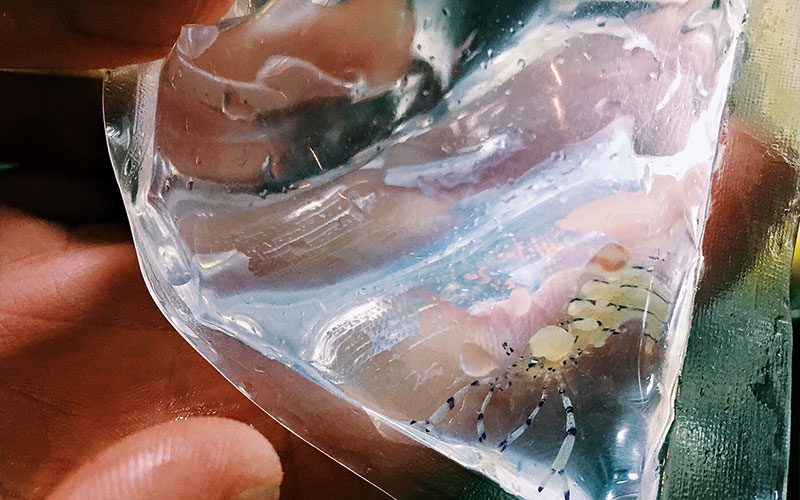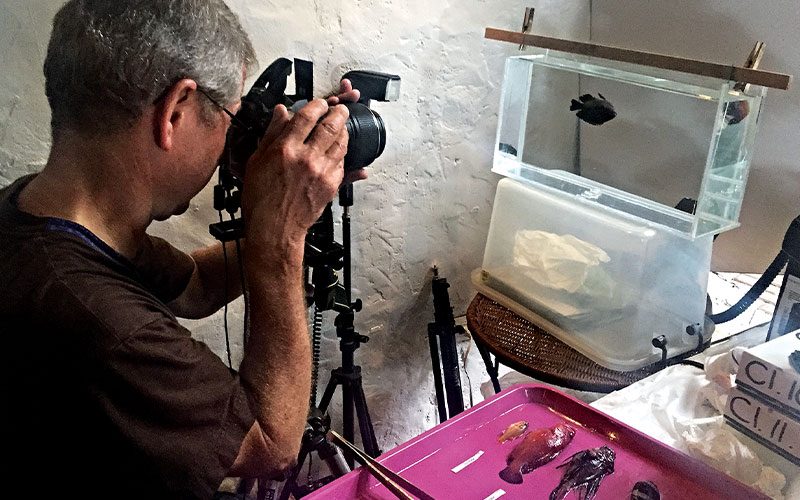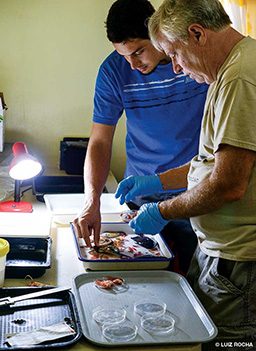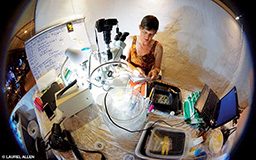The mood on the boat is somber — a psychological match for the heavy, flat gray skies pressing down on the chop outside. As the open-air Bangka motors back toward Sabang, Philippines, the only other sounds are the shrieks of seabirds wheeling overhead, the creak of bamboo outriggers slapping across waves and metallic clangs as exhausted rebreather divers shed equipment onto the deck.
These divers have just dragged themselves out of the toughest conditions they, as a team, have faced. “Visibility down to 10 feet in places, crazy downcurrents that just rip your mask off,” says Elliott Jessup, head of scientific diving at the California Academy of Sciences, “plus 60 degrees at depth and up to 4-knot currents during decompression.” After a long, panic-tinged hunt for the team’s surface marker buoy, which was being held underwater by strong currents, even the boat crew is tired.
Only what the divers found at 450 feet explains why, despite the challenges, they did this dive and will do it again tomorrow. As members of the academy’s “twilight zone” team, they’re four of roughly a dozen scientists in the world exploring some of Earth’s richest, most critical and most mysterious coral reefs. The dives are deep, the decompression is long, the task loads are intense, and the risks are ever-present. But the rewards — for science, for ecosystem protections and for helping even nondivers care about unseen ocean worlds — trump it all.
Welcome to the Twilight Zone
The twilight zone (more accurately but less cleverly known as the mesophotic zone) is defined as the narrow band of ocean that falls between 150 and 500 feet. Below the limits of recreational scuba technology but above where researchers tend to send expensive remotely operated vehicles (ROVs) and other submersibles, it’s a place few people in the world ever see, much less enter. It’s also swarming with fish, corals and other invertebrates unknown to science.
That’s particularly true in and around the Verde Island Passage, an area of the Coral Triangle often called “the center of the center of marine biodiversity.” In partnership with the Philippine government, national museum and others, the academy has been launching expeditions here for more than a decade, and this year’s effort involves more than 40 scientific divers with a wide range of expertise. Jessup, ichthyologist Luiz Rocha, Steinhart Aquarium director Bart Shepherd and doctoral student Hudson Pinheiro are just taking that science deeper.
Behind the Mask
Closed-circuit rebreathers (CCRs) are still uncommon enough to alarm airport security officials, but it’s no longer rare to meet a diver who drops to twilight-zone depths. The difference between recreational or even technical CCR diving and actually working at a depth of up to 500 feet, though, is significant.
No matter where they are in the world, this team’s expeditions are unrelenting. The average dive lasts four to five hours, bottoms out at 300 to 500 feet and provides the team with about 10 to 40 minutes of time at depth. Decompression schedules for what they’re doing “don’t exist,” Jessup says. “Working changes everything. We’re pushing the envelope, so we have to base the schedules on super-conservative calculated risk.” Because they don’t know what they’ll find on any particular dive, the team plans for a depth range instead of a specific depth and has multiple contingency plans.
They operate in a three-days-on, one-day-off pattern; Jessup says the dry days are “as important for our physiology as they are for the psychological state required for these dives.” But with equipment maintenance, specimen work and emails to answer, those dry days aren’t really days off. As the weeks tick by, the crew relies heavily on discipline, routine and the energy of teammates.

In the water each diver is equipped with a scooter, two 80-cubic-foot cylinders of bailout gas and the specific tools of his trade. For Jessup this means a 70-pound, 4,000-pixel (4K) video camera the size of a file cabinet. For Shepherd, Rocha, Pinheiro and Brian Greene (a diver specializing in mesophotic fish, who has joined them for this trip), it means a combination of nets, collection bags, measuring tapes, spears, cameras and more.
Because of the equipment they’re carrying, the tasks they have to execute and the limited time they have to get those tasks done, “we have to be really aware of not exerting ourselves at depth,” Jessup says. “One issue is that you absorb gasses you don’t want faster. The other is work of breathing — the harder you work, the harder you breathe, and if you’re trying to breathe gas that’s now denser at depth, that’s not a good combination on a rebreather. At 200 feet it’s not so much of an issue for us; at 500 feet it could start to become one.”
Jessup — who is constantly consuming papers and lectures on dive physiology and is always ready to chat about topics such as physician Simon Mitchell’s work on insufficient respiratory volume — addresses working at depth in two general ways. First, the team uses a higher percentage of helium than recreational CCR divers tend to use (70 percent versus 50 or 60 percent). Second, they train for efficiency. “Each diver has a single scientific task,” he says. “That increases the likelihood that they’ll be efficient at that task and that they’ll come back alive.”
For scientists who want to tackle the mesophotic zone’s biggest questions, twilight-zone work requires the kind of personal risk-versus-rewards assessment more common among astronauts than academics. It also demands a serious commitment to remembering that gathering knowledge, no matter how important, is actually the secondary task.
“Working with scientists is awesome because you’re training people who are mission-oriented and have a task that matters,” Jessup says. “It’s also a nightmare because you’re training people who are mission-oriented and have a task that matters. Making sure they never forget that the true primary task is staying alive, especially with scientists who have a lot of diving experience, can be incredibly difficult.”

The Waters Between Us
Like any good team, the academy crew has to work constantly to mesh their backgrounds, perspectives and priorities into a unified goal. And like any good team, their differences also make them a broader, more capable whole.
Jessup began diving recreationally at 15; he quit a “miserable corporate marketing” job in his 20s to move to Egypt and become a divemaster. He started traveling the world while investing in increasingly technical training, became focused on scientific diving a few years later and then joined the academy as dive safety officer (DSO) in 2011 to build its scientific diving program. He likes “that aha moment when you teach a scientist something he realizes will make his work better.” In the water he’s methodical, cool and decisive — one of those people whose obvious competence adds a level of calm.
With approximately 25 years of scientific diving under his belt, Shepherd is passionate about giving museum visitors the most beautiful, realistic, compelling experience of underwater ecosystems possible. In preparation for a 2016 twilight-zone exhibit, his priority in the Philippines is to collect live animals for transport back to the academy. His staff is on the forefront of marine husbandry; the strange container he often carries on dives is part of a fish decompression chamber prototyped by biologist Matt Wandell.
Rocha, the academy’s ichthyology associate curator, was born in João Pessoa, Brazil. He was diving long before he was old enough to take his first class and has been trying to answer big questions about fish speciation (how and why evolution gives rise to new species) almost ever since. Those questions get bigger and weirder in the twilight zone, where Rocha’s priority is to collect specimens for DNA sequencing. That’s the most conclusive way to figure out what an animal is and where it fits on the tree of life — and it’s turning up new species left and right.

Pinheiro, a doctoral student and ichthyology researcher at the academy, is so wildly enthusiastic about fish that it often borders on hilarity. He’s hard-working, stubborn and known for diving in a T-shirt and socks so as not to miss an opportunity to catch a specimen. His task on these dives is to run a series of transect surveys at various depths, one of the best ways to map the biodiversity and workings of an ecosystem. Hundreds of thousands of such surveys have been done in shallow reefs; about 30 — all by Pinheiro and Rocha — have been done in the mesophotic zone.
Today the team’s “unified goal” was not as unified as it needed to be. (“The conditions,” Jessup says, “revealed some weaknesses.”) So after trudging off the dive boat and carefully rinsing gear, the crew disappears behind closed doors for several hours. When they come out, they’ve agreed on a slew of ways to tighten up existing protocols, and they’ve added a few new ones.
For starters, they’ve formalized predive meetings and postdive reviews: Everyone must be present, surface support included; no phones, unnecessary personnel or distractions are allowed. They’ve talked a lot about situational awareness. And they’ve adopted a “call it down” system that is associated with NASA astronauts, in which any mistake, no matter how small, gets immediately confessed and talked about with the team.
Last, they’ve instituted a new mantra for predive checks. When asked to recite their No. 1 task right before dropping, these driven, focused, big-brained scientists no longer mention catching, shooting or measuring anything. They say, “Primary task: Stay alive.”
Rise Above
When we drop in on the team’s final decompression stop, they are hooked in behind a small reef, seeking relief from the current’s intense drag on the scooters, collection bags, cameras and tanks that stream behind them. They hand over most of their stuff and tuck back in to wait out their remaining hour of deco.

Back on the boat, the eight cylinders the divers carried are a physical manifestation of the teamwork this effort requires. Four bottom gases are joined by a 190-foot bottle, a 120-foot bottle, a 70-foot bottle and a 20-foot bottle. “Some divers can be totally self-contained,” Jessup says later, “but doing science changes that. Our dives wouldn’t be possible without a team bailout strategy.” Surface support could help out on later decompression if needed, but the inescapable truth is this: To do the work — and to ensure they always return home from it — these divers need each other.
“What the team is doing at Cal Academy,” says Alistair Dove, a biologist and associate editor at Deep Sea News, “is really opening up new frontiers for biodiversity research. It’s an extraordinary thing.” And it’s a thing that the academy won’t stop doing, says the academy’s executive director Jon Foley, referencing a “10- to 20-year mission to explore these crucial coral-reef ecosystems.”
The twilight-zone team will continue to travel the world, dropping deeper, triggering airport security faster and overwhelming boat captains more than scientific divers ever have. What they find — and how quickly they find it — won’t just add to the world’s new-species lists, it may help determine how well our own species learns to protect some of the strangest, most incredible reefs we’ll never see.
Explore More
Watch scientists from the California Academy of Sciences discuss Pressure in the Twilight Zone.
© Alert Diver — Q3 Summer 2015

